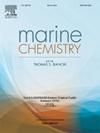Spatial and temporal dynamics of groundwater biogeochemistry in the deep subsurface of a high-energy beach
IF 3
3区 地球科学
Q2 CHEMISTRY, MULTIDISCIPLINARY
引用次数: 0
Abstract
Intertidal sandy beach systems are considered complex biogeochemical reactors. At beach sites that are subject to high tidal and wave energy, seawater circulation can reach tens of meters deep into the subsurface and changing environmental conditions are assumed to lead to dynamic groundwater flow paths, saltwater-freshwater mixing zones, and a spatio-temporally variable groundwater biogeochemistry. Previous studies mainly focused on the upper meters of subterranean estuaries (STE), while the deep subsurface remained a black box. This study presents spatial (cross-shore) and temporal (∼ six-weekly, over 1.5 years) dynamics of the groundwater biogeochemistry that were observed down to 24 m below the ground surface (mbgs) of a sandy high-energy beach on Spiekeroog Island (Germany).
In addition to redox conditions along a cross-shore transect ranging from oxic to Fe oxide reducing/slightly sulfidic, we found a previously unknown, distinct vertical redox zonation as well. Temporal variations of the biogeochemistry within low salinity groundwater at the most landward station close to the dune base were mainly driven by storm flood related seawater infiltration. Around the high water line, the extent of the upper saline plume (USP) varied over time. Furthermore, temporal dynamics of the O2 saturation at 6 mbgs indicated a seasonally shifting depth of the oxycline at this location. In the lower intertidal zone, groundwater solute concentrations displayed a temporally variable zone of deep freshwater discharge.
Regarding the impact of the deep STE on the groundwater biogeochemistry of the discharge zone, our data revealed that nutrient, Mn, and Fe release along the deep flow paths through the USP towards the discharge zone was limited, likely due decreasing availability of labile organic matter and subsequent slowing down of metabolic processes with depth. High concentrations of metabolites in the upper ∼ 2 mbgs of the discharge zone were, therefore, rather attributed to the incorporation of labile organic matter during continuous and storm flood related sediment relocation and/or the contribution of older waters, e.g., the subtidal saltwater wedge.
高能海滩深层地下水生物地球化学的时空动态变化
潮间带沙滩系统被认为是复杂的生物地球化学反应器。在潮汐能和波浪能较强的海滩地点,海水循环可深入地下数十米,环境条件的变化被认为会导致动态地下水流路径、咸淡水混合区和时空多变的地下水生物地球化学。以往的研究主要集中在地下河口(STE)的上层,而深层地下水仍是一个黑箱。本研究介绍了在德国斯皮克罗格岛(Spiekeroog Island)高能量沙质海滩地表下 24 米处观察到的地下水生物地球化学的空间(跨海岸)和时间(每六周一次,历时 1.5 年)动态变化。在靠近沙丘基部的最靠近陆地的站点,低盐度地下水中生物地球化学的时间变化主要是由暴雨洪水相关的海水渗透造成的。在高水位线附近,上盐羽流(USP)的范围随时间而变化。此外,6 mbgs 处的氧气饱和度的时间动态变化表明,该处的富氧层深度随季节变化。关于深层 STE 对排泄区地下水生物地球化学的影响,我们的数据显示,营养物质、锰和铁沿着穿过 USP 的深层水流路径向排泄区的释放是有限的,这可能是由于可溶解有机物的可用性降低以及随之而来的新陈代谢过程随深度的减慢。因此,排泄区上部 ∼ 2 mbgs 的代谢物浓度较高,可能是由于在与沉积物迁移相关的持续和暴雨洪水过程中吸附了可溶性有机物,以及/或老水(例如潮下咸水楔)的作用。
本文章由计算机程序翻译,如有差异,请以英文原文为准。
求助全文
约1分钟内获得全文
求助全文
来源期刊

Marine Chemistry
化学-海洋学
CiteScore
6.00
自引率
3.30%
发文量
70
审稿时长
4.5 months
期刊介绍:
Marine Chemistry is an international medium for the publication of original studies and occasional reviews in the field of chemistry in the marine environment, with emphasis on the dynamic approach. The journal endeavours to cover all aspects, from chemical processes to theoretical and experimental work, and, by providing a central channel of communication, to speed the flow of information in this relatively new and rapidly expanding discipline.
 求助内容:
求助内容: 应助结果提醒方式:
应助结果提醒方式:


